There’s something about an antique spinning wheel that evokes a bygone era of simplicity and hard work. Perhaps it’s the way the wood is worn from years of use, or the delicate intricacy of the machinery. Whatever the reason, these beautiful pieces of history continue to capture our imagination.
Do you have an antique spinning wheel that you would like to identify and value? If so, you have come to the right place! In this blog post, we will provide a guide to help you determine the age and value of your spinning wheel. We will also discuss some of the different types of spinning wheels that were popular during different periods in history. So, whether you are just curious about your antique spinning wheel, or are thinking about selling it, this guide is for you!
Table of Contents
Brief History of Spinning Wheel
A spinning wheel is a tool that was used to spin thread or yarn from raw fiber. It replaced the earlier method of hand spinning with a spindle. The spinning wheel was first invented in China around the year 1030. It quickly spread to the rest of Asia and then to Europe, where it was used to produce high-quality fabrics for clothing and other purposes. The spinning wheel remained the primary tool for textile production for centuries until it was eventually replaced by the power loom in the early Industrial Revolution.
Today, the spinning wheel is primarily used by hobbyists and craftspeople who appreciate the traditional method of fabric production. However, it still plays a vital role in many parts of the world where electricity is not readily available. In these areas, the spinning wheel is often the only way to produce much-needed fabrics for clothing and other purposes.
For many, an antique spinning wheel is more than just a decoration. It’s a reminder of a time when things were made by hand, with care and precision. In a world that often feels mass-produced and impersonal, an antique spinning wheel is a tangible connection to our past. The spinning wheel is one of the most ubiquitous tools in human history, and its influence can be seen in art, literature, and other expressions of culture from around the world.
Types of Antique Spinning Wheels
Spinning wheels have been used for centuries to turn raw fibers into thread or yarn. While the basic design of the spinning wheel has remained constant over time, there are a variety of different types of antique spinning wheels that can be found today.
Great Wheel
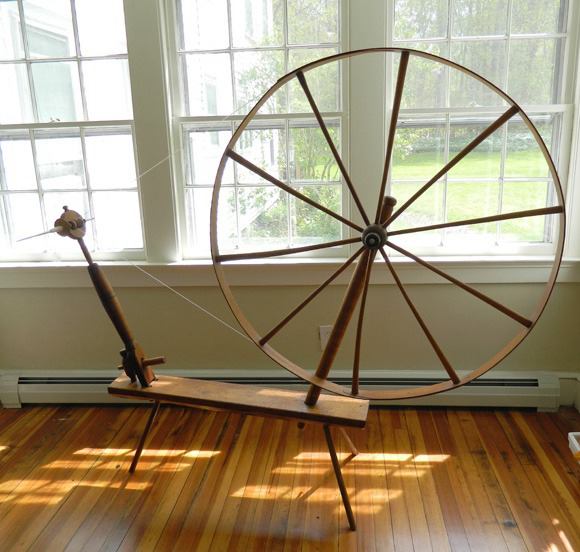
The most common type of spinning wheel is the Great Wheel, which was first used in Europe in the Middle Ages. This type of spinning wheel is characterized by its large size and heavy wooden construction.
A great wheel was traditionally used to spin wool, but it can also be used to spin other types of fibers such as flax or cotton. The spinning process begins with the preparation of the fiber, which is teased out into individual strands and then drawn onto a rotating spindle. The spinner then uses a hand-held device called a brake to slow down the speed of the spindle, allowing them to add a twist to the fibers and turn them into thread or yarn. Once the desired amount of twist has been added, the spindle is brought back up to speed and the thread is wound onto it.
Great wheels were once a common sight in homes and villages across Europe, but they are now mostly found in museums and private collections.
Saxony Spinning Wheels
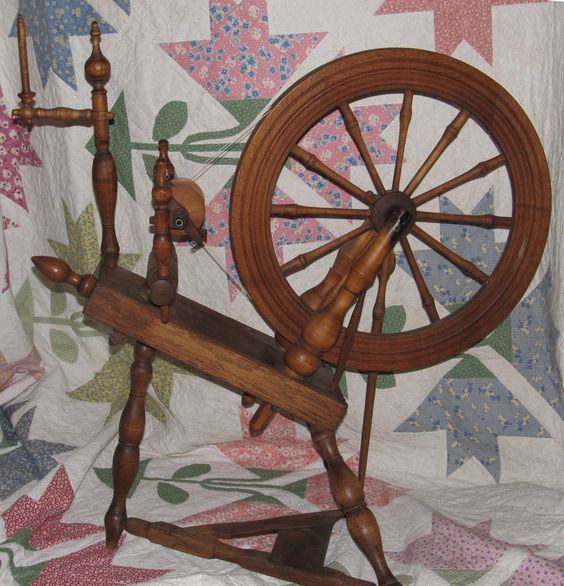
Saxony spinning wheels are a type of spinning wheel that was first developed in the German region of Saxony. The key feature of a Saxony spinning wheel is its horizontal “mother-of-all” or main drive wheel, which is connected to a vertical “ flier” or spindle. This design allows the spinner to sit facing the drive wheel, making it easier to see and control the spinning process.
In addition, the Saxony spinning wheel typically has a larger flywheel than other types of spinning wheels, which helps to maintain a consistent speed and rhythm while spinning. Today, Saxony spinning wheels are still popular among fiber artists and spinners and are considered to be one of the best designs for hand-spinning yarn.
Norwegian Spinning Wheels
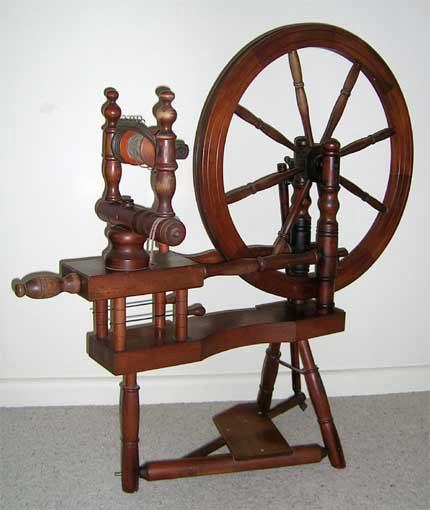
Norwegian spinning wheels have a strong resemblance to Saxony wheels. The most notable difference is that Norwegian wheels include four legs and a bench frame. This allows the spinner to sit comfortably while working, and also provides extra stability. Norwegian wheels are also slightly smaller than Saxony wheels, making them more portable. In addition, Norwegian wheels typically have a higher ratio, which means that they can spin finer yarns.
However, the smaller size and higher ratio also make Norwegian wheels more challenging to use. As a result, they are best suited for experienced spinners who are looking for a portable wheel that can produce high-quality yarns.
Charkha Wheels
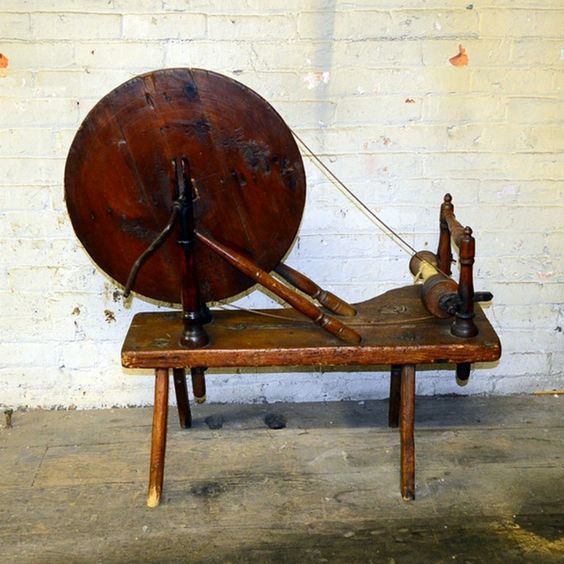
A charkha is a traditional spinning wheel that has been used in India for centuries. The word charkha comes from the Sanskrit word meaning “to spin,” and it is thought to have originated in the Indus Valley region. The charkha is typically made from wood, and it consists of a large wheel that is attached to a spindle. The spindle is turned by hand, and the thread is wound onto it as it spins.
The charkha is an essential tool in the production of yarn, and it has also been used as a symbol of national identity and pride. In recent years, the charkha has gained popularity as a decorative item, and it is often seen in homes and office spaces.
Castle Spinning Wheel
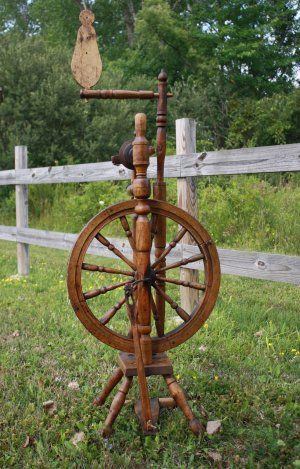
The castle spinning wheel is a type of spinning wheel that is distinguished by the flyer being positioned above the wheel. This design allows the spinner to see the yarn as it is being spun, making it easier to control the thickness and twist of the yarn. Castle wheels are also often equipped with a built-in orifice hook, which makes adding new yarn a quick and easy process.
Spinning Jenny
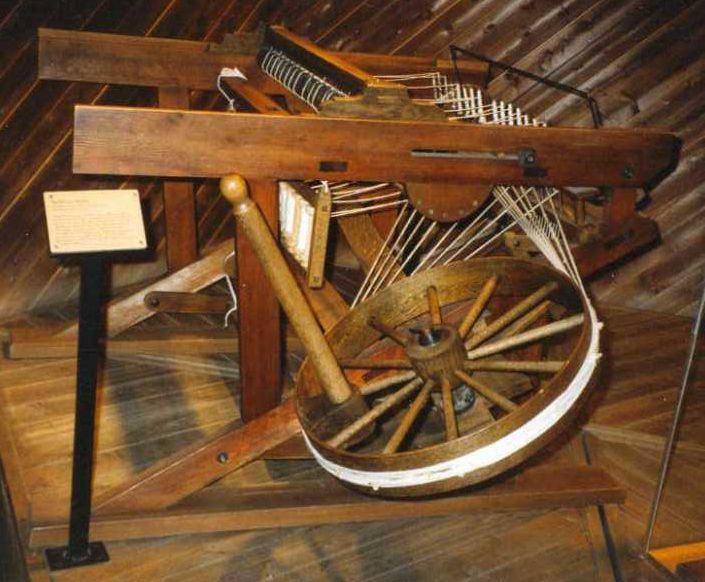
The Spinning Jenny was one of the first machines to be used in the textile industry. It was invented by James Hargreaves in 1764, and it quickly became an essential tool for spinners and weavers. The machine allowed for a much higher output of thread than could be achieved by hand, and it quickly became popular with manufacturers. The Spinning Jenny was eventually replaced by more efficient machines, but it remains an important part of the history of the textile industry.
Antique Spinning Wheel Parts
An antique spinning wheel is a beautiful and intricate piece of machinery. Although it may look daunting at first, understanding the parts of a spinning wheel is surprisingly simple.
Drive Wheel/Flywheel
The drive wheel is responsible for storing energy and keeping the spindle in motion. It is often made of wood or metal, and it is attached to the axle by means of a band or belt. The drive wheel also plays an important role in regulating the speed of the spinning wheel. By adjusting the tension on the band or belt, spinners can increase or decrease the speed at which the wheel turns. As a result, the drive wheel/flywheel is a vital part of any antique spinning wheel.
Drive Band
The drive band is a loop of leather or fabric that is attached to the flywheel and the drive wheel. The drive band must be kept tight in order to work properly. If the drive band is too loose, it will slip and the wheel will not spin. If the drive band is too tight, it can break.
Treadle/Pedal
It is a platform that the spinner stands on while operating the wheel. The treadle is connected to the wheel by a series of belts or gears, which transfer power from the spinner’s feet to the wheel. This power is used to spin the flyer, which in turn spins the yarn.
Flyer & Bobbin
The flyer is a small metal or wood disk that is attached to the spindle. It has grooves that wrap around the yarn, helping to twist it as it is spun. The bobbin is a small cylinder that holds the twisted yarn. It is attached to the flyer and revolves around the spindle as it is being filled. Without these two parts, it would be very difficult to create a strong, consistent thread.
Mother of All
The Mother of All is the main shaft that runs through the center of the spinning wheel. It provides support for the other parts of the wheel and helps to keep everything in alignment. It typically consists of a long, straight piece of wood with a grooved surface that extends from the floor to the top of the spinning wheel.
Maidens
These are the vertical bars that hold the flyer mechanism in place. Without maidens, the spinning wheel would be unable to function. The maidens also help to keep the flyer in line with the drive band pulley. In addition to their functional role, maidens also add to the aesthetic appeal of an antique spinning wheel.
Orifice
The orifice is the part of an antique spinning wheel that the thread is fed through. It is usually located at the top of the wheel and is made up of two parts: the head and the guard. The head is a small, knob-like piece that fits into a hole in the guard. The guard sits over the head and has a small hole in the center through which the thread is fed. The orifice is held in place by a pin that goes through both the head and the guard.
Antique Spinning Wheel Identification Guide
In the days before commercial spinning machinery, every home had at least one spinning wheel. Today, antique spinning wheels are highly sought-after by collectors. If you’re lucky enough to find an old spinning wheel at a market or garage sale, you may be wondering how to identify it.
Examine the Craftsmanship
If you are trying to identify an antique spinning wheel, the first thing you will want to do is look at the overall design of the wheel. Spinning wheels went through a number of different design changes over the years, so by looking at the overall shape and style of the wheel, you can often narrow down its age.
Take a close look at the construction of the wheel. Many antique spinning wheels were handmade with great care and attention to detail, and they often display intricate carving and joinery work. Pay attention to small details like the shape of the spindles and the way the wood is ornamented. These features can give you clues about the origins of the wheel. If you see any evidence of machine-made parts or sloppy workmanship, it’s likely that the spinning wheel is not as old as you thought.
Examine the materials used. Early spinning wheels were made almost entirely of wood, while later models often included metal or plastic components. By understanding the construction of antique spinning wheels, you can get a better sense of its era and value.
Signs of Use
Examine the condition of the wheel. Antique spinning wheels were built to last, but over time they can suffer from wear and tear. Look for signs of damage like cracked or missing pieces of wood. Also, pay attention to any repairs that have been made to the wheel. These can often be telltale signs of its age and history.
Another clue is the presence of asymmetrical pieces. In early spinning wheels, the pieces were often asymmetrical, due to the handicraft methods used to create them. Today, most wheels are mass-produced, so the pieces are typically symmetrical. Therefore, if you see an asymmetrical piece on a spinning wheel, it’s likely that the wheel is an antique.
Antique Spinning Wheel Makers Marks
In the past, spinning wheels were generally made by local artisans who didn’t have the need or inclination to brand their products. As a result, most antique spinning wheels are unmarked. This can make it difficult for collectors to determine their age or value. If they did have maker marks, they were usually found on the underside of the table or the treadle.
Some of the most valuable spinning wheels were produced by Jesse Truesdell between 1815 – 1855 and they have a maker’s mark “J. Truesdell.”. Other popular maker’s marks include “E.S. Williams.” and “Farnham”.
Assessing the Antique Spinning Wheel Value
Anyone who has ever stepped into an antique shop knows that not all old things are created equal. While some may be lucky enough to stumble upon a priceless relic, others may find themselves holding nothing more than a dust-covered POS. So, how can you tell if that spinning wheel you just bought at the flea market is actually an antique? And more importantly, what is it worth?
Condition of the Antique Spinning Wheel
An important factor to consider is the condition of the wheel. If your spinning wheel is in good condition, it will be worth more than a comparable wheel that is in poor condition. However, finding a spinning wheel that is still in working order can be a challenge. Many of these items have been damaged or broken over the years, and even those that have been carefully preserved may no longer be able to spin.
If your spinning wheel is missing or broken parts, this can subtract from its value. For example, a spinning wheel that is missing its foot pedal or one of its spindles will be worth less than a comparable wheel that is in good condition.
The cost of a minimal restoration can range anywhere from $100-$200, while fixing and replacing more parts may end up costing even more. Depending on the severity of the damage, a broken or missing spinning wheel should typically cost under $100. Likewise, antique spinning wheels in excellent condition can be listed for even more, for example, this Saxony spinning wheel from the early 1800s is listed at $885.
The Rarity of the Spinning Wheel
Antique spinning wheels are relatively inexpensive, costing around $300 for a simple horizontal wheel. However, if you have a rare or early model spinning wheel, it will be worth more than a more common one. Mahatma Gandhi’s Charkha spinning wheel was appraised at $75,000 back in 2016. Looking for antique spinning wheel makers marks can help you determine if you have a rare piece at hand.
Getting the Antique Appraised
If you are thinking about selling your antique spinning wheel, there are a number of places you can go to get it appraised. Antique stores and auction houses are always a good option, as they will have experts who can give you an accurate value for your spinning wheel. There are also a number of free websites where you can get your antique spinning wheel appraised, like Country Living Magazine or InstAppraisal.
You can also use WorthPoint to determine for how much are similar antique spinning wheels listed for on different websites.
Helpful Resources
Here are some helpful resources for determining antique wheel identification and value:
- A Pictorial Guide to American Spinning Wheelsby David A. Pennington
- Spinning Wheels and Accessories(Schiffer Book for Collectors) by Michael B Taylor and David A. Pennington
- The Alden Amos Big Book of Handspinning: Being A Compendium of Information, Advice, and Opinions On the Noble Art & Craftby Alden Amos
Where to Sell Antique Spinning Wheels
Antique spinning wheels are a popular collectible, and there are a number of different places where they can be sold.
Selling on Ebay or Etsy
You can often find these wheels – along with spinning wheel parts like bobbins and drive bands – on sites like Ebay and Etsy. Prices can vary widely, but most antique wheels fall in the $200-$450 range.
When posting your spinning wheel for sale online, be sure to include clear and accurate photos as well as a detailed description of the wheel. Include information such as the age, condition, provenance, and any other relevant details. By providing potential buyers with all of the necessary information, you will increase the chances of selling your spinning wheel for a good price.
Auction Houses
Auction houses like Pook & Pook or Michaan’s Auctions are always a good option, as they will have experts who can give you an accurate value for your spinning wheel. You can also post your spinning wheel for sale on online auction websites like LiveAuctioneers or Bidsquare.
Antique Dealers
Whether you want to sell your antique spinning wheel or simply appreciate the history and artistry of this item, you’re sure to find something special at your local antique dealer store. You can find local antique dealers on websites like Manta or Antique Store Finder.
Selling Locally
Local brick-and-mortar stores that deal in antiques are always a good option. You can also take your spinning wheel to flea markets or set up a booth at a local craft fair. In addition, there are a number of online platforms where you can list your spinning wheel for sale, such as Facebook Marketplace and Craigslist.
Final Thoughts
If you’re an antique lover, then you know the excitement of finding that one item that you’ve been searching for years. Whether it’s a rare piece or just something to complete your collection, when you find what you’re looking for, it feels great. That’s why we put together this guide on antique spinning wheels; we want to help everyone from the beginner collector to the experienced expert track down and identify that perfect spinning wheel.
If you have an antique spinning wheel and are curious about its value, the best thing to do is get it appraised by a professional. There are many factors that go into determining the worth of an antique spinning wheel, such as age, rarity, and condition. However, this guide should give you a good idea of what your spinning wheel might be worth. Thanks for reading!






![Vintage Schwinn Bikes: [Types, Identification, and Values]](https://www.txantiquemall.com/wp-content/uploads/2022/05/5.-Schwinn-1967-Ramshorn-Fastback-Stingray-Sky-Blue-vtg-600x450.jpg)
